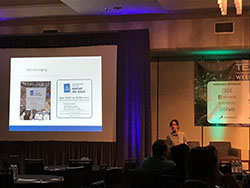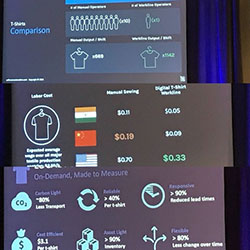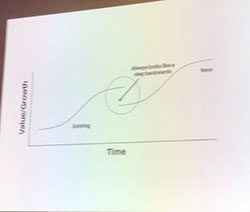The Many Sides of Digital Transformation and a Need for an RPA Reboot – a TEXWeek Recap

Key Takeaways from TEX Week 2018

Here are a few of my highlights and take-aways:
On day one, Brenton Harder of BNY-Mellon delivered the keynote speaking on the influence of technology to the speed of change. He spoke on the importance of leadership not getting in the way of innovation by enforcing the status quo. Change is uncomfortable. In fact, you would not even notice change except for the disruption in your comfort zone. Change may even initially feel like you are stepping backwards, but this is necessary to move forward. This was illustrated with this Growth / Value chart. He also spoke on the importance not getting bogged down too much data. “Infobesity,” in Brenton’s words, is a real issue, and to make real change the right data must be considered in parallel with process. He challenged the audience to open their windows and look outside their own group, organization, and even company. Failure to do so may result in you not seeing or addressing the next disruption in your space.
- When speaking on Business Intelligence, Dave Castellani of NY Life, talked about the challenges of “Big Data”. Having too much data will prevent you from seeing what is meaningful. Another challenge is that many companies are pushing forward with new technology and are ignoring legacy systems. Legacy is real and must be considered when implementing new technology. It cannot simply be wished away, and it will not go away overnight.

With the increasing cost of labor worldwide, it was important for the fashion industry to identify ways to reduce cost and make the process more efficient. (Fun fact: Did you know that every T-shirt requires 10 people to make?) 
While the points were good and the technology cool, when it comes to Digital Transformation as a term, things were far from clear. In fact, during the round table discussions and networking sessions I was able to have conversations with individuals about what this new industry buzz word, “Digital Transformation”, encompasses. In every instance, it became abundantly obvious that there is no clear understanding of what Digital Transformation is or means. Depending on who you talk too, what google page you find, or analyst group you reference, that term will take on different meanings. What is clear is that, regardless of the company you work for, if you can tie your project to Digital Transformation, or at least put that term on one of your slides to executives, you are more likely to get approval and funding. In one example, I spoke to group that had all their procedures in a three-ring binder. Their project spent a quarter scanning and converting them to PDF. Time and resources approved why? You guessed it, because they “digitally transformed” them.
Others struggled with where to begin their Digital Transformation journey. “Do we start with process or with strategy?” (Both will be great blog topics for another time)
This is all unfortunate because at its essence, what Digital Transformation encompasses is incredibly important. Today every business is digital and touches the Internet of Things in some way. Every business handles continuously growing mountains of internal and external data. Every business must strive to create and optimize the best customer experiences possible. Every business must be able to look at their complete operations through the lens of their holistic processes to ensure ideal business performance as well as ongoing compliance with regulations like the brand new GDPR. Don’t do all of these and risk disruption. Sadly, as crucial as it is, the term “Digital Transformation” will be misunderstood, over used and diluted until it gets pushed aside as providing little value. (You may recall when Lean & Six Sigma were all the rage for identifying opportunities for process improvements. Now, sadly, that community and it’s influence are much smaller.)
Another interesting part of some very candid conversations dealt with another buzz word that is currently a hot topic; Robotic Process Automation (RPA). Because it is a cool term that has a lot of attention and gets funding, many companies have been quick to adopt and implement some form of automation. Unfortunately for them, many fell prey to the fancy talk that many BPM and RPA vendors poured on by freely throwing around the term and speaking about how fast they could implement. They are now realizing that RPA, or automation of any kind, requires planning, strategy, and an understanding of your process. As we have stated many times, just because you can automate something does not mean that you should. If you do not understand the process or how it works, you will just do bad things faster and be more efficient at being inefficient. In fact, we spoke to multiple companies that are now backing out their automation implementation to get a handle on understanding the process. There has been a lot of concern about how automation might mean the elimination of jobs. As some have found, doing it wrong most certainly will.
Overall it was a very informative conference. It was also good to have the time to speak open and candidly with those taking the lead in the Digital Business Transformation and RPA space. We look forward to continuing those conversations in the coming month.
If you would like more information on Digital Transformation and Automation, here are a few posts you may be interested in:
 On day one,
On day one,